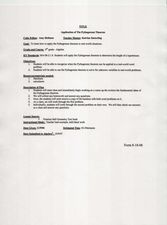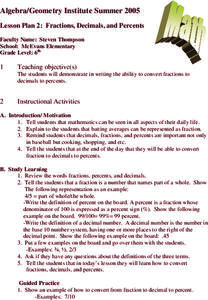Curated OER
Go Yankees!
Students use the internet to research the New York Yankees baseball team. After gathering their information, they discuss the challenges faced by the team and how they were overcome. They end the lesson by examining the math and...
Curated OER
Dollars and Cents Word Problems
These are some cheap items! Learners explore cost with this addition word problem which has them examine the price of a baseball and a pencil. They add them together to find the total spent. Because there is an explanation below,...
Curated OER
Math League Baseball: Five Week Project
Eighth graders analyze how to use statistics, change fractions to decimal, and graph their statistics. They draft players from Major League Baseball eams and chose on player for each position, including 3 oufielders and one designated...
Curated OER
New Kids in The Hall
Young scholars assess the role of statistics in determining those athletes chosen to be inducted into the Baseball Hall of Fame. They work in small groups to calculate, chart, and graph various statistics for different Hall of Fame members.
Curated OER
Range, Mean, Median and Mode Through the Internet
Middle schoolers compute measures of central tendency. In this range, mean, median and mode lesson, students gather information on the internet, organize the data and then compute the measures of central tendency. They create a...
Curated OER
Decimals in the Dugout
Students investigate place value and decimals during baseball related activities. In this place value lesson, students explore place value with decimals. Resources are included.
Curated OER
Wampum
Students explore different ways of trading to get what they want. In this algebra lesson plan, students explore goods, money, services and exchange. They compare the use of money to the use of potlach.
Curated OER
Agriculture Counts
Students discuss the kinds of things they count and how to use tally marks. In this social science lesson, students count animal crackers by using tally marks for each kind of animal. The tally marks are changed into numbers and one...
Curated OER
Solving Multiple-Step Problems
Students listen to the explanation of lesson and how to do the worksheet by observing examples on the board. They then work on their own to complete the worksheet of multiple-step problems.
Curated OER
Sports Math
Fifth graders participate in a variety of sports related problem solving equations that involve fractions, decimals and percents. They explain the relationships and equivalences among integers, fractions, decimals and percents with a...
Curated OER
Customary Units of Weight
In this customary units of weight worksheet, students use the math table that shows the normal weight of balls used in various professional sports. Students use the numbers in each table to solve the problems.
Curated OER
Probability and Statistics
Students are taught to search the internet for statistics concepts on sports. In this probability lesson, students collect data and use the calculator to graph and analyze their data. They graph and make predictions about sports using...
Curated OER
Application of the Pythagorean Theorem
Students find the length of the hypotenuse using the Pythagorean Theorem. In this geometry lesson, students solve for the different parts of a right triangle. They work the first problem with-the teacher then work on their own.
Curated OER
Ratios
Sixth graders investigate the concept of ratios and how they can be used to represent the comparison of quantities. The lesson is taught using a table or graph to compare two categories of data.
Curated OER
Probability
Sixth graders explore the concept of probability. In this probability lesson, 6th graders collaborate to collect spinner data based on the likelihood of spinning odd and even numbers. Students complete 2 other probability activities and...
Curated OER
Fractions, Decimals, and Percents
Sixth graders engage in a lesson that explores the conversion process of fractions, decimals, and percents in relationship to their values to each other. Students demonstrate how to convert numbers interchangeably between fractions,...
Curated OER
The Berenstain Bears' Mad, Mad, Mad Toy Craze
Students explore personal finances. In this money management lesson, students read The Berenstain Bears' Mad, Mad, Mad Toy Craze. Students examine the spending habits of Brother Bear and Sister Bear. Students analyze opportunity costs as...
Curated OER
The Slope of a Curve
Students graph the slopes of a line using the intercepts. In this precalculus lesson, students identify the properties of a curve slope. They find the limit and use a graping calculator to graph their lines.
Curated OER
Balloon Ball Bounce
Students explore the rebound of balls. In this energy conversion lesson, students explore the physics behind the rebound of various types of sports balls. Through the experimental design process using balloons, students investigate and...
Curated OER
Geometry - Angles Overview
Learners address 14 questions that include naming all pairs of opposite and supplementary angles for sets of intersecting lines and then, finding the measure of the unknown angle. They determine the measure of the angle that is...
Curated OER
The Majors and the Minors
Students create ways to compare and contrast major league and minor league baseball players using statistical tables. Video segments spur a discussion on the differences between a major league player and a minor league player. Students...
Curated OER
Subtract 13 and 14
In this subtraction practice learning exercise, students use problem solving skills in order to solve 6 math word problems that require them to subtract 1 digit numbers.
Curated OER
Find a Pattern
For this patterns worksheet, 2nd graders find the pattern in 1 word problem and then solve it. Students answer 1 short answer math problem directly related to the first word problem.
Curated OER
Minimum and Maximum of a Graph
Students find the solutions of polynomials through graphing. In this algebra lesson, students identify the maximum and minimum of each polynomial function. They ind the vertex, domain and range of a parabola.

























